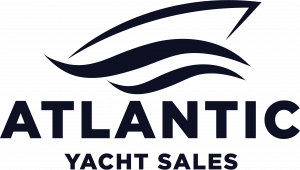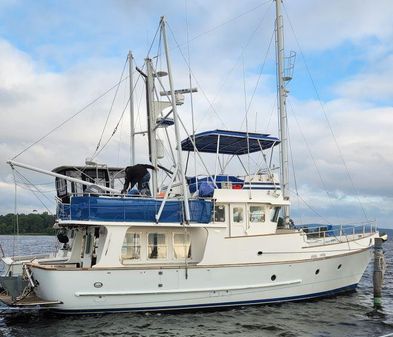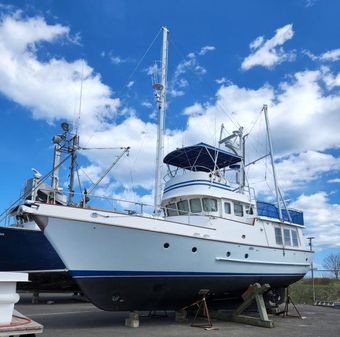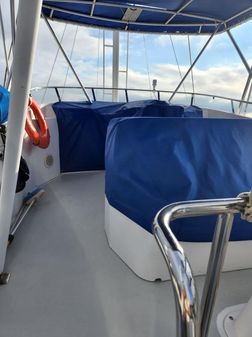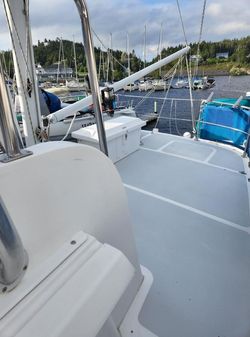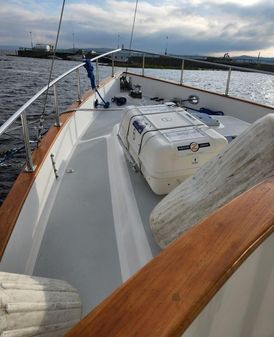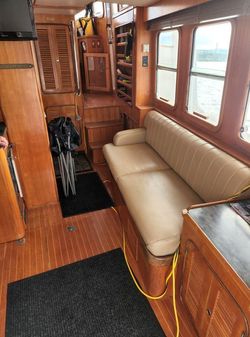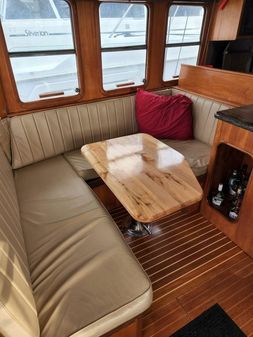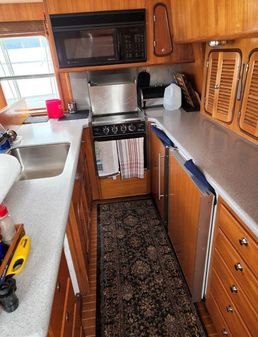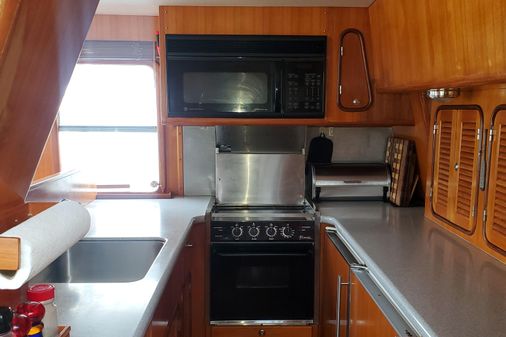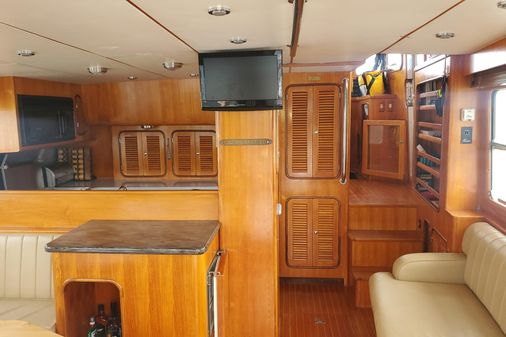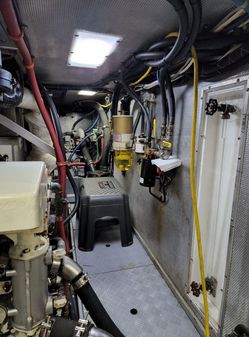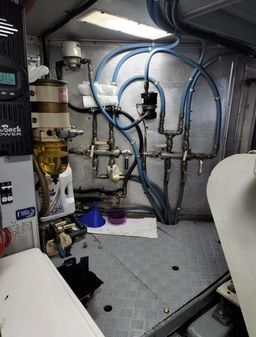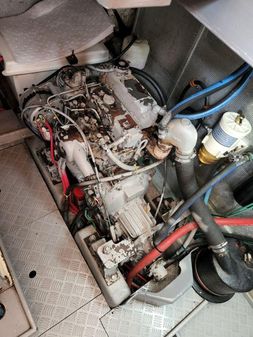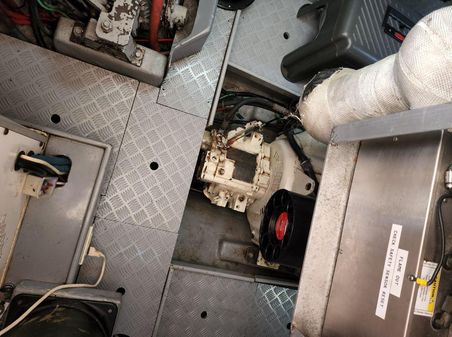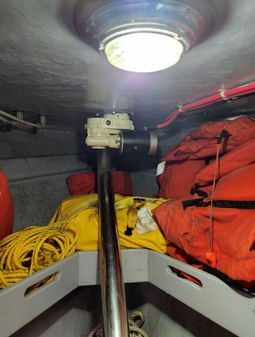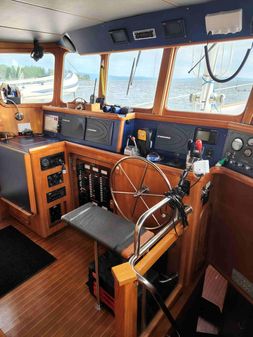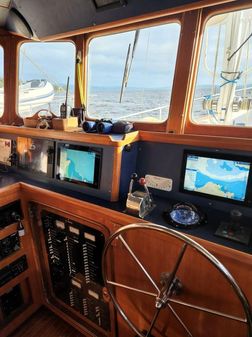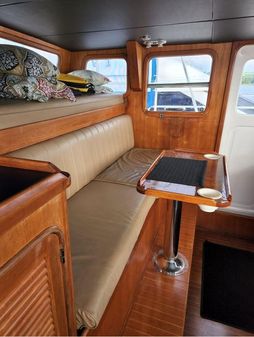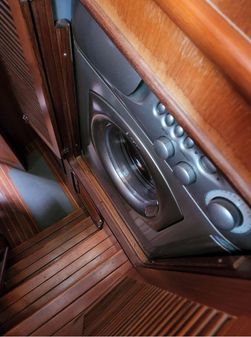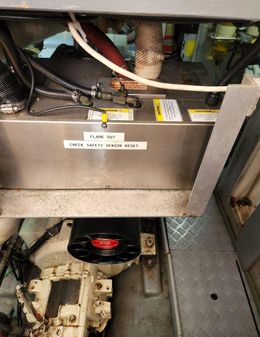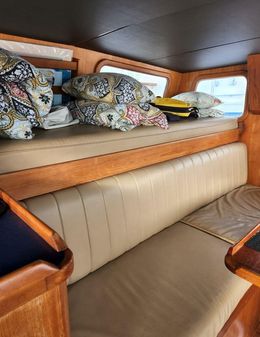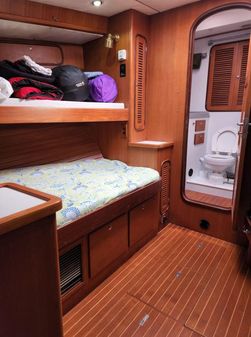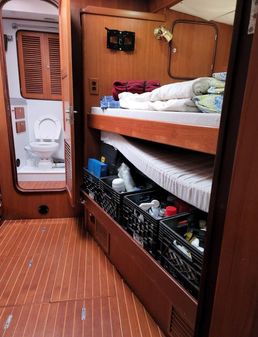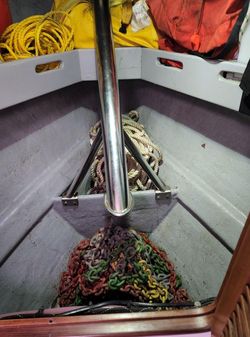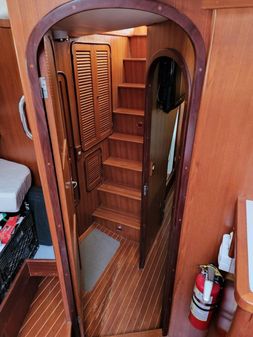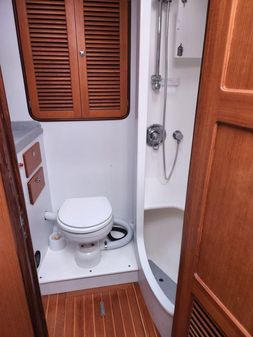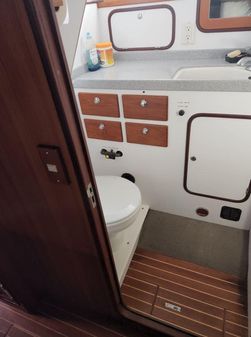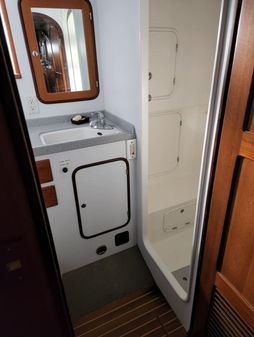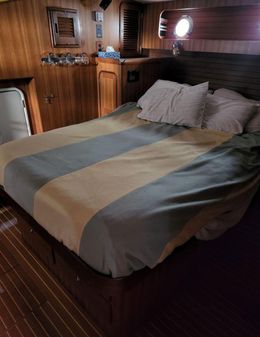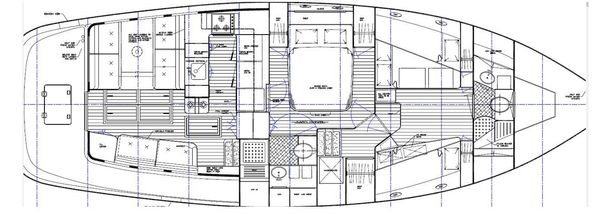Basic Boat Info
Dimensions
Engines / Speed
- Make: Lugger L668D
- Model: Lugger L668D
- Fuel: Diesel
- Engine Power: 143hp
- Type: Inboard
- Year: 1999
Tanks
Other
Contact
Office
4425 Hwy 3
Chester, NS, CA, B0J 1J0
Tel:902-593-1280
The Company offers the details of this vessel in good faith but cannot guarantee or warrant the accuracy of this information nor warrant the condition of the vessel. A buyer should instruct his agents, or his surveyors, to investigate such details as the buyer desires validated. This vessel is offered subject to prior sale, price change, or withdrawal without notice.
Builder: Pacific Asian Enterprises
Designer: Jeff Leishman
LOA: 45' 9"
LWL: 38' 4"
Beam: 15' 3"
Draft: 5' 5"
Displacement: 60,000 lbs
Pale blue fiberglass hull, white decks and deckhouses; raised pilothouse design with optional fly-bridge. The pilothouse has access doors to the Portuguese Bridge port and starboard; heavy rub-rails; asymmetric cabin arrangement with fore-and aft covered side deck on the starboard side. The deep cockpit is mostly covered by the boat deck. There is a substantial transom door to a swim platform. Welded stainless steel rails forward of the Portuguese Bridge the length of the vessel. Chain locker, forward; fiberglass deck box on the boat deck. The boat deck has a substantial aluminum mast, lifting boom and out-riggers with para-vanes for stability. There are two electric winches; spare set of para-vanes. There is a second taller mast forward with crows-nest.
Note that the listed vessel has two single, upper and lower berths to starboard in the forward stateroom, in addition to a double berth to port. Access to the staterooms is from the wheelhouse. There is an enlarged galley and pantry.
The pilothouse has an amidships helm, settee and anthwartships watch berth; new headliner in the pilot-house (2023). Access to the staterooms is via a companionway in the pilothouse on the starboard side.
Master stateroom is amidships, w/ walk-around queen berth and ensuite head/shower area. The guest stateroom is forward w/ double berth to port and upper and lower berths to starboard. Generous storage below in drawers and lockers, and a head/shower compartment forward.
The salon/galley area is aft w/ direct access to the cockpit via a heavy sliding door. The “asymmetrical” wide-body salon has a large L-shaped settee and Maple dining table to port, and generous settee to starboard.
The large galley is forward to port, w/ Corian countertops, Princess 3 burner electric stove with oven; GE Profile Performance microwave oven, Summit commercial refrigerator and freezer; Ariston washer and dryer combination unit; Raritan ice-maker (not working).
The yacht has a 300 gallon fresh water capacity supplying hot and cold water to the two heads and the galley; new pressure pump. There is a Sea Recovery water-maker rated at 53 gallons/hr. (the owner has not used the water-maker and it may need attention); hot water heater (2022). She has two Raritan electric heads each is fitted to a 25 gallon holding tank with a ‘Y’ valve for overboard discharge. The after head has new plumbing and a ‘Y’ valve; new check-valve and mascerator pump. Each head has a shower, sink and vanity.
The yacht has teak bulkheads, teak and holly sole; vinyl headliner; tan ‘Ultra-Leather’ upholstery. She has 3 Cruisaire air-conditioning units (16,000 BTW each; 2 need repair) plus a Hurricane hot-water diesel furnace with new circulating pump.
1999 Lugger model #LP668D, naturally aspirated; 6 cylinder; John Deere block; cruising speed: 8 kts.; hour meter showing 5,489 to the time of listing; dry stack exhaust with keel-cooler, fresh-water cooling; new exhaust silencer w/ heat blanket (2022); 2” propeller shaft; Twin Disc model #5050 transmission with a 3:1 reduction gear. There is a 1999 Yanmar 3GM30F wing ‘get-home’ engine with a dedicated shaft and folding propeller; fresh water cooling; hour meter showing 82 operating hours; Racor R25S filter; new alternator on the wing engine (2023). The wing-engine alternator will now charge the house battery system. There is an ABT bow thruster; new continuous duty engine room blower with temperature control and monitor The yacht has a 1,000 gallon fuel capacity in FIBERGLASS tanks; 2 Racor 75/900 series fuel filters in parallel; 2 fuel transfer pumps, one with fuel polisher (new kit on the Groco pump).
The yacht has 12 and 24 volt DC systems and a 110 volt AC system. The 110 volt system is supplied with by shore-power connection or via an 8 KW Northern Lights auxiliary generator in a hush box w/ new sea-water pump and fuel pump. There is 3425 hours on the generator at the time of listing. There are 4D & 8D lead/acid batteries in 4 banks: house, main engine, take-home engine; generator and bow-thruster. The house system batteries are new; as is the main engine starting battery (2022). There are circuit breaker panels for all systems; 960 watt solar panels; LED lights in all fixtures.
Icom VHF model #IC-M412; Sailor VHF & loud hailer; 2 (recent) Furuno RADARS: #DRS6A-X Class; and X-DRS4D-NXT; 3 (recent) Furuno 12” multi-function displays with charting system, model TZ Touch 2 w/ Ethernet capability; WRX 220 weather sensor; 2 Robertson Autopilots w/ new compass and rudder feed-back; B&G Hydra System: depth speed and log; Depth sounders integrated in the Furuno displays; 2 Ritchie compasses; AIS transmitter and receiver; 2 Dynex televisions; Kenwood stereo system; Garmin GPS Map 740
The Nordhavn 46 is the result of years of experience and research done in recognition of the need for a yacht possessing world cruising capability that is manageable by today's cruising couple. The 46-foot Long Range Cruiser offers a combination of technical features, luxury accommodations, overall performance, and aesthetic appeal. This vessel will travel comfortably, quietly, reliably, and safely at 8.5 knots for up to 3,000 miles. P.A.E. Yacht Builders in Dana Point have built a solid reputation for designing and producing MASON series sailboats. The Nordhavn 46 is a serious offshore powerboat designed for the sailor who desires the advantages of a power boat. Underway, the aft deck is quiet and exhaust-free (just like sailing). The displacement hull, with its gracefully designed transom, creates a minimum wake at cruising speed. The dry exhaust eliminates diesel smoke and noise, and the 30-foot propeller, driven through a three-to-one reduction, minimizes the vibration and cavitation noise. The aft salon and wheel house doors may be left open without sucking the exhaust gas into the salon. The large main salon leaves room for a passageway on the starboard side. The port side provides space for handling dock - spring lines, and transom-type doors on both the port side and the starboard side provide easy boarding. A Portuguese bridge wraps completely around the wheelhouse, and a door in the bridge coaming allows easy access to the foredeck. The entire deck area is finished with a non-skid raised molded diamond pattern. There is adequate room on the boat deck for a large inflatable rigid tender. The yacht's boom or an optional davit can raise and lower the dingy. The spar can accommodate instrumentation, antennas, radar, and a steadying sail. Access from the aft deck is provided by a ladder. The wheelhouse is located amidships where the pitching motion of the yacht is felt least, a detail that is important in offshore conditions. The position of the wheelhouse combined with the forward angle of the windows, Portuguese bridge coaming, and high bows make storm damage highly unlikely. The offwatch partner can sleep within reaching distance of the person on watch, which is particularly important on a couple-crewed yacht. The settee back folds up making the single-watch bunk into a comfortable double berth. The wheelhouse is an excellent place to dine, as it offers a panoramic view and cross-ventilation through open windows and doors. The owner's stateroom is amidships to minimize motion, and the noise level is very low. The heavy, sound insulated, structural bulkhead separates the stateroom from the engine room. Plenty of natural ventilation is provided through four opening hull ports and on deck, dorade-type vents. Included are queen-size berth, vanity, and two large hanging lockers (one under steps). The guest stateroom features a large double-berth, with an opposing settee - single-berth. The stateroom has excellent ventilation, a separate head with stall shower, spacious hanging lockers, and is separated from the owner's stateroom with solid structural bulkheads. The main salon's open and airy living area measures eleven feet by twelve feet, offering room for a wood-burning fireplace, and an L-shaped settee and two easy chairs provide seating for six. Opening marine windows provide ventilation, light and a view of the yacht's surroundings, and the partially shaded after deck is accessed through a large sliding door. Out of the main stream of salon traffic, the efficiently designed galley has abundant storage and counter space. Room is provided for a microwave oven and trash compactor, and there is an abundance of natural light and ventilation. The engine room is accessed via a floor hatch or through a walk-in door in the aft head compartment. Numerous large hatches are provided within the main salon solely for major repair or removal of equipment, and a small hatch and ladder are provided when access through the head compartment is impractical. There's partial head room within the engine compartment and space is provided for easy maintenance of engine(s), generator, and the ship's machinery. Producing an ocean-going yacht with unlimited range necessitates the full displacement hull. There is no way to get the combination of range, seakindly motion, structural integrity, and load-carrying capability, and still have a planing hull. While semi-displacement hulls are capable of higher speeds with horsepower, they also require significantly more horsepower at low speeds. This higher power requirement consumes more fuel, requires larger engines, and generates more noise and vibration. The pitching motion of the displacement hull is much softer than that of the semi-planing hull. The deep entry of the displacement hull eliminates pounding, and the easier entry and increased weight cause less deceleration and acceleration as the vessel passes through head seas. Running off the wind, the displacement hull with its full-length keel and large attached rudders offers better directional control and is easier to handle for helmsman or autopilot. The true displacement hull provides maximum stability, seakindliness, and economy. Hull shape plays a large part in steering performance. Any vessel designed to run at speed length ratio of over 1.6 must rely upon lift to semi-plane over the water. A broad, flat transom is required to generate this dynamic lift. Characteristically, this type vessel steers badly with the seas on the quarter or astern. The Nordhavn's full-displacement hull, designed to run at an S-L of 1.34, does not need the dynamic lift and therefore has a properly designed stern for down wind running. Even equipped with twins, it handles better than the semi-displacement vessel. A single 143-hp engine provides plenty of power and allows a cruising range of 3,000 nautical miles with 1,000 gallons of fuel. The single configuration is beneficial for several reasons. The large, slow-turning single propeller is completely protected from floating debris within the propeller aperture and will not make contact with the ocean bottom in the event of an unintentional grounding. In a twin engine application, not only are the propellers vulnerable, but the propeller shafts, shaft struts and, more importantly, the rudders are in equal danger. Almost all modern vessels used in the world's fisheries have single propulsion engines, and those that have two engines generally drive one propeller shaft. A 46.8-horsepower propeller drives this hull to a speed of 8.3 knots (9 knots is possible with some sacrifice in range). Having the large rudder directly behind the propeller and full length keel causes the vessel to steer more easily under adverse conditions. A common complaint among twin engine, semi-displacement, flat-transomed hulls, is the difficulty in maintaining directional control while running off the wind. This causes fatigue for the helmsman, excessive wear and tear for autopilot and steering gear, and an uncomfortable ride. In a single engine application, the engine can be located in the lowest possible hull position and, therefore, the shaft angle from the engine to the propeller can be minimized. Ideally, the thrust should be as close to perpendicular as possible to the vessel's waterline. In other words, a completely horizontal shaft line is best. In a twin engine application the engines must be moved outboard, not in the lowest part of the hull. The props must be located as deep as possible so there is no choice but to increase shaft angle. The loss of efficiency in a twin engine installation is due to the drag of two rudders, along with two propeller shafts and shaft struts, the greater slip of the two smaller propellers, the mechanical inefficiency of two smaller engines and their respective transmissions, and the increased shaft angles of each engine. In a single engine configuration the rudder lies directly behind the keel and when it is not deflected during a course correction, it adds very little additional drag. Twin engines can easily be provided. A 27-hp Sailboat diesel auxiliary driving a separate shaft with a folding propeller (an attractive alternative to twin engines) can be installed alongside the main engine. This auxiliary can provide up to 6 knots of headway. The auxiliary can be fitted with high-output alternators, A.C. generators, or refer compressors to further justify its installation. An electric or hydraulic bow thruster is available for additional maneuverability. With a displacement hull, twin engines are requested for only two reasons: reliability and low-speed docking maneuverability. In lieu of twins, a combination of a bow thruster and wing engine are recommended. With this combination, the vessel's seakeeping qualities are not compromised, and greater maneuverability and reliability will be achieved than with the typical twin engine configuration. NORDHAVN DESIGN COMMENTS: 1. Displacement - Length Ratio (D-L) is a useful tool in comparing the relative weights of different size vessels. As noted by the renowned naval architect, R. Beebe, a vessel around 50-feet LOA with a displacement length ratio under 270 would not be suitable for a true ocean crossing vessel. A vessel with a D-L below 270 would have a hard time carrying the fuel and supplies needed for a long range trip, and would not offer a motion at sea tolerable for a long passage. The D-L of the Nordhavn is 383, heavy by yacht standards, but a D-L in excess of 450 is considered normal for a true fishing trawler. The 383 D-L is a result of the Nordhavn's 8,000 pounds of ballast, heavy construction scantlings, and large fluid capacities. This D-L ratio results in a seakindly motion and load carrying capability. The addition of 2,021 pounds results in a submersion of only one inch if the load is evenly distributed. 2. The Above Water - Below Water Ratio (A-B ratio) is the side-view ratio of area of the vessel above water to that below water. With the demand for luxurious accommodations and the cost per pound of building yachts, the A-B ratio can get beyond acceptable limits for the ocean cruising vessel. An A-B ratio between 2.1 and 2.6 is proper for this type of yacht with a ratio as low as possible preferred. The Nordhavn has an A-B ratio of 2.3. 3. The prismatic coefficient and speed - length ratio should be viewed together. The prismatic coefficient is a comparison of the actual volume of the hull below the waterline in cubic feet to what the volume would be if the body were a 'prism' composed of the largest section from the lines carried the full length of the waterline. The designer will massage the lines of his design to develop the prismatic coefficient that best matches the desired speed - length ratio of the vessel. In a full displacement hull the maximum efficient speed - length ratio is 1.34. This figure represents 1.34 x the square root of the waterline. If a vessel is designed with maximum range as a goal, without regard to speed, the designer would probably select a prismatic coefficient which would match up with a lower speed - length ratio. The prismatic coefficient selected for the Nordhavn is 63 which matches up with the maximum speed - length ratio of 1.34. This means the Nordhavn is designed to run most efficiently at 8.3 knots. 4. Due to a combination of form and ballast stability, the Nordhavn has the ability to right itself in the most severe conditions. Approximately 68,000 foot pounds is required to heel the Nordhavn 30 degrees, 92,000 foot pounds for 60 degrees, and 56,000 foot pounds for 150 degrees. 120 degrees is the target for positive stability as adopted by the USYRU for offshore sailing yachts. The Nordhavn beats this target by another 30 degrees.
GENERAL: Northstar 70# anchor with 300’ of galvanized chain; spare anchor and rode; Maxwell #3500 electric anchor windless with pilot-house and foredeck controls; dock-lines and fenders; Marineco SPL wireless search light; Whale Gusher 320 electric bilge pump; high-water electric bilge pump with alarm; manual bilge pump.
SPARE PARTS: 2- electric winches for the dinghy crane; 155 amp Alternator for the main engine; set of new main engine injectors; set of new glow-plugs and injectors for the generator; Johnson circulating pump and nozzle and control parts for the hot-water heating system; 65 amp Alternator for the wing engine; msc. gaskets & engine parts; blower for the engine room; bow roller; Groco vented loop for a head.
The Company offers the details of this vessel in good faith but cannot guarantee or warrant the accuracy of this information nor warrant the condition of the vessel. A buyer should instruct his agents, or his surveyors, to investigate such details as the buyer desires validated. This vessel is offered subject to prior sale, price change, or withdrawal without notice.
